Managing golf course putting greens presents its own unique challenges. Often, sand-based root zones are used for putting greens to eliminate the potential for standing water and for particle stability (2). However, some of the major challenges associated with sand-based root zones are low nutrient retention and decreased soil health (1, 9).
Soil health refers to the capacity of living soil to provide productivity, maintain or enhance air and water quality, and support biological health (5). Included within soil health are a variety of physical, chemical and biological properties and processes. Physical and chemical properties generally are harder to change over a short period with noninvasive management changes, but biological properties are often more sensitive to management changes (4).
Biological soil health indicators include microbial biomass, soil respiration and nitrogen mineralization. Soil respiration or potentially mineralizable carbon (PMC) is a measurement of carbon dioxide production during a soil incubation (6). It can be used as an indicator of soil microbial activity and plant-available nitrogen provided by microbial activity (6). Potentially mineralizable nitrogen (PMN) is the amount of plant-available nitrogen that is released from the soil during a soil incubation and is another measurement of microbial activity and the nitrogen-supplying power of the soil (6, 8). Improving biological soil health can lead to improvement in soil structure, water-holding capacity, and nutrient cycling and availability (4).
Humic substances are complex mixtures of materials formed by reactions during the decay and transformation of microbial and plant remains (7). Humic products can positively affect root architecture and growth, abiotic stress tolerance, photosynthesis and respiration, and nutrient use efficiency (3). The first objective of this field experiment was to determine whether incorporating humic substances in fertilizers improved turfgrass soil health, especially biological properties. The second objective was to determine whether the addition of humic substances to fertilizers allowed for a reduction in nitrogen rates while maintaining turfgrass quality and cover.
Methods
A field study was conducted from spring 2019 through the end of the growing season in 2020 at the Iowa State University Horticulture Research Station in Ames, Iowa. The experiment was conducted on a mature Penncross creeping bentgrass (Agrostis stolonifera L.) putting green. The putting green had a sand-based root zone that met United States Golf Association specifications. Turfgrass was maintained using a reel mower at a 0.14-inch (3.56-millimeter) height of cut and was mowed six times per week, with the clippings removed after each mowing. Irrigation was applied as needed when rainfall was not sufficient to prevent drought stress. Preventive fungicides were applied to minimize turfgrass injury.
The fertilizer treatments were humic-coated urea (HCU), HCU at two-thirds rate, HCU + humic dispersing granules (HDG), HCU + black gypsum dispersing granules (BGDG), urea, and a non-treated control. Fertilizer nutrient analysis, application rate and frequency, and yearly totals can be found in Table 1, below. Treatments were applied to the same plots in both years of the study.
Click on table to enlarge:
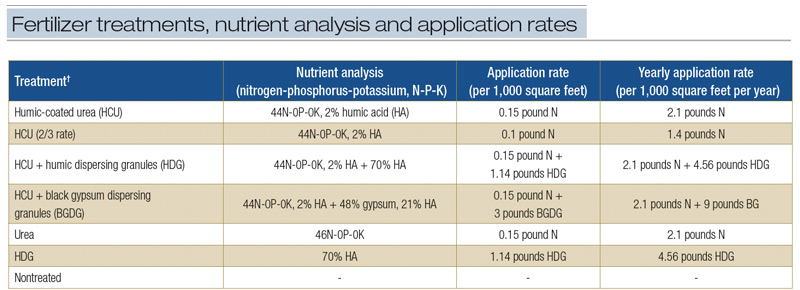
†Urea, HCU and HCU (two-thirds rate) were applied every two weeks from April to October. HDG was applied in April, May, September and October. BGDG was applied in April, July and October in 2019 and 2020.
Table 1. Fertilizer treatments, nutrient analysis and application rates during the field study from spring 2019 through the 2020 growing season.
Turfgrass health and performance were evaluated with biweekly measurements of visual quality, percent green cover and dark green color index (DGCI). Percent green cover and DGCI were determined using digital image analysis from digital images collected using a light box. Clippings were collected monthly, dried and weighed to determine clipping biomass. Soil moisture and compaction were measured monthly. Soil samples were collected in spring of each year after fertilizer applications and at the end of the growing season. From these soil samples, soil nutrient concentrations, pH, cation exchange capacity (CEC), soil organic matter, microbial biomass (microbial biomass carbon [MBC] and microbial biomass nitrogen [MBN]), and microbial activity (PMC and PMN) were measured.

Right: Among other tests, researchers measured soil respiration, or potentially mineralizable carbon, to determine carbon dioxide production during a soil incubation. Photo by Alex Lindsey
Results
Turfgrass plant health
Fertilizer treatments had a positive effect on visual quality ratings throughout the duration of the study (Figures 1 and 2, below). Fertilizer treatments applied at 0.15 pound nitrogen/1,000 square feet (7.32 kilograms/hectare) every two weeks (i.e., HCU, HCU + HDG, HCU + BGDG, and urea) provided acceptable visual quality rating (6 or above on a 1-9 scale) on all rating dates within the experiment. Reducing the application rate to 0.1 pound nitrogen/1,000 square feet (4.88 kilograms/hectare) applied every two weeks (i.e., HCU at two-thirds rate) maintained acceptable visual quality ratings on all but two rating dates. Treatments that did not receive any nitrogen (i.e., HDG and non-treated) only provided acceptable visual quality ratings on two rating dates.
Overall, HCU at two-thirds rate performed similarly to the fertilizer treatments applied at the higher nitrogen rate and outperformed the non-treated control and HDG. However, more research is needed to determine whether this result is due to the nitrogen alone or the combination of humic substances and nitrogen application. Additionally, incorporating humic substances in fertilizer applications did not improve turfgrass visual quality compared with fertilizer alone.
There were not as many differences between treatments in terms of percent green cover (Figure 3, below). Six weeks after initial fertilizer applications, all treatments that had received nitrogen provided 95% or greater percent green cover. On the last rating date of the growing season, treatments that had received nitrogen maintained greater percent green cover compared with the non-treated control and HDG. In general, reducing the nitrogen rate provided similar percent green cover compared with the higher nitrogen rates and outperformed the treatments that received no nitrogen. Once again, it is unclear whether this result is due to the combination of humic substances and nitrogen or nitrogen alone. Furthermore, incorporating humic substances in fertilizer applications did not result in greater percent green cover compared with fertilizer alone.

Figure 1. Effects of fertilizer treatments on a sand-based Penncross creeping bentgrass putting green in Ames, Iowa, in 2019 and 2020. HCU, humic-coated urea; HDG, humic dispersing granules; BGDG, black gypsum dispersing granules.
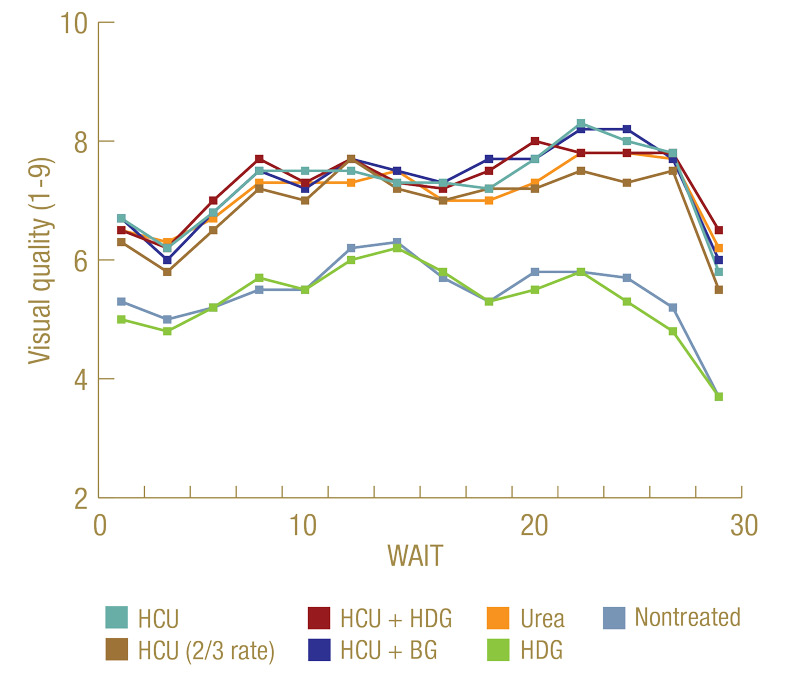
Figure 2. Effects of fertilizer treatments on visual quality ratings (1-9 scale, where 1=poor, 9=ideal and 6 and up=acceptable) of a sand-based Penncross creeping bentgrass putting green in Ames, Iowa, in 2019 and 2020. Treatment mean comparisons were separated using Fisher’s protected least significant difference (LSD) at the p≤0.05 level and were placed under each rating date. HCU, humic-coated urea; HDG, humic dispersing granules; BGDG, black gypsum dispersing granules; WAIT, weeks after initial treatment.
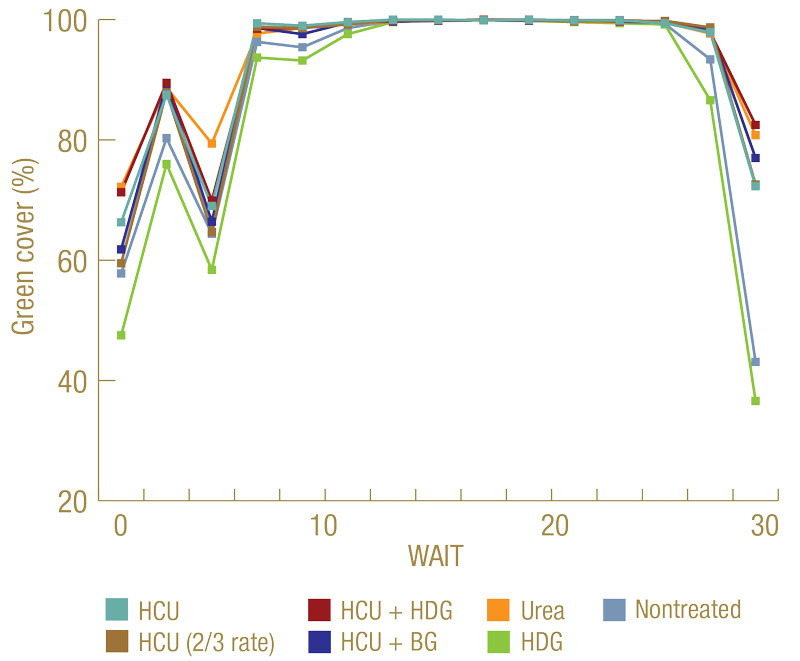
Figure 3. Effects of fertilizer treatments on percent green cover of a sand-based Penncross creeping bentgrass putting green in Ames, Iowa, in 2019 and 2020. Treatment mean comparisons were separated using Fisher’s protected least significant difference (LSD) at the p≤0.05 level and were placed under each rating date. HCU, humic-coated urea; HDG, humic dispersing granules; BGDG, black gypsum dispersing granules; WAIT, weeks after initial treatment.
There were minimal treatment differences in terms of DGCI and no treatment differences in clipping biomass (data not shown). Overall, incorporating humic substances in fertilizer applications did not increase turfgrass quality, cover and clippings compared with fertilizer alone. However, addition of humic substances to fertilizers at a reduced nitrogen rate resulted in acceptable turfgrass quality and cover during this study. Thus, incorporating humic substances in fertilizers at a reduced nitrogen rate could be used in a sustainable and environmentally friendly fertilizer program.
Turfgrass soil health
Fertilizer treatments did not have an effect on soil moisture and compaction, pH, CEC, or nutrient concentrations besides sulfur (data not shown). In general, it is difficult to change chemical and physical soil properties with short-term management changes (4).
Editor’s note: Soil compaction is a “hidden” stressor that takes a very visible toll on turf. Check out Soil compaction effects on turf growth to learn about the impacts on plant root and shoot growth, nutrient uptake, water use, and more.
Minimal treatment differences were seen in terms of soil organic matter (data not shown). Compared with the non-treated control, HCU (two-thirds rate) and HCU + HDG had 0.7% and 0.4% greater soil organic matter, respectively. Plant-available soil concentrations of sulfur were 18% greater for HCU + BGDG compared with all other treatments. This result can be explained because HCU + BGDG was the only treatment that contained gypsum, which contains sulfur. Furthermore, the soil sulfur concentrations were likely increased from the gypsum and not the humic substances. Future research should be conducted to determine the long-term effects of humic fertilizers on physical and chemical soil properties.
Click on table to enlarge:
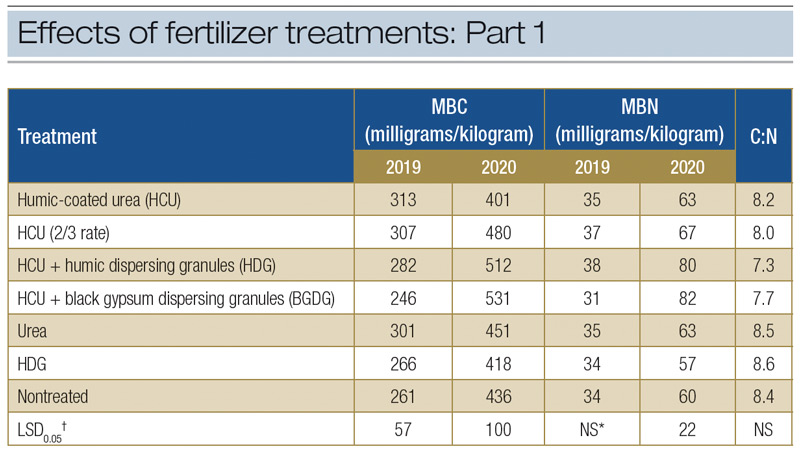
†Treatment mean comparisons were separated using Fisher’s protected LSD at the p≤0.05 level
NS*, nonsignificant at the 0.05 probability level
Table 2. Effects of fertilizer treatments on soil microbial biomass carbon (MBC), microbial biomass nitrogen (MBN) and microbial biomass carbon-to-nitrogen ratio (C:N) of a sand-based Penncross creeping bentgrass (Agrostis stolonifera L.) putting green in Ames, Iowa, in 2019 and 2020.
Fertilizer treatments had an effect on microbial biomass over time (Table 2, above). There were no treatment differences in terms of carbon-to-nitrogen ratio (C:N). In the second year of the study, HCU + BGDG had a 30% increase in MBC compared with HDG and HCU alone, and a 40% increase in MBN relative to the non-treated control and HDG. However, HCU + BGDG did not increase microbial biomass compared with urea alone. Overall, HCU + BGDG provided the largest increase in microbial biomass in the second year of the experiment.
Click on table to enlarge:
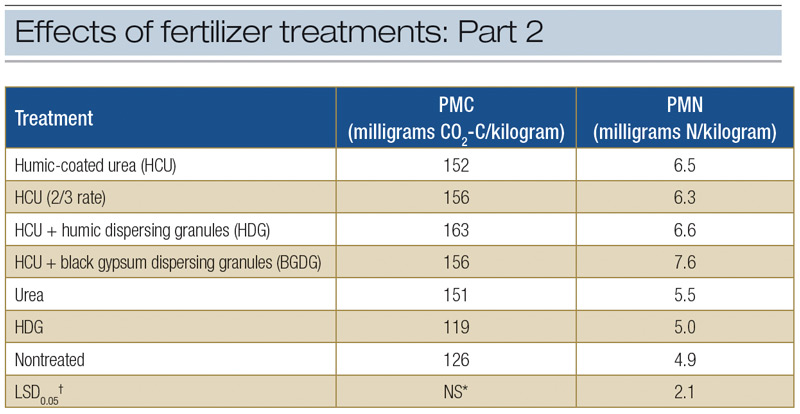
†Treatment mean comparisons were separated using Fisher’s protected LSD at the p≤0.05 level
NS*, nonsignificant at the 0.05 probability level
Table 3. Effects of fertilizer treatments on potentially mineralizable carbon (PMC) and potentially mineralizable net nitrogen (PMN) of a sand-based Penncross creeping bentgrass (Agrostis stolonifera L.) putting green in Ames, Iowa, in 2019 and 2020.
Only one fertilizer treatment, HCU + BGDG, had an effect on microbial activity (Table 3, above). Incorporating humic substances in fertilizers and fertilizer alone did not increase PMC compared with the non-treated control. However, HCU + BGDG resulted in 54% greater PMN relative to the non-treated control and HDG. Furthermore, all other treatments performed similarly in terms of PMN. The addition of BGDG to the fertilizer application increased the PMN compared with HCU and urea by 17% and 38%, respectively. It appears that the addition of humic substances with gypsum or possibly the gypsum alone increased microbial activity in terms of PMN. Future research should incorporate BGDG with fertilizers at reduced nitrogen rates to determine whether it can provide acceptable turfgrass quality while improving or maintaining soil health compared with higher nitrogen rates.
Conclusion
Overall, incorporating humic substances in fertilizers did not improve or increase turfgrass quality, cover and clippings compared with fertilizer alone. Fertilizer treatments had minimal effect on physical and chemical soil properties except for soil sulfur concentrations. The treatment containing gypsum — HCU + BGDG — increased the plant-available soil sulfur concentration. The addition of humic substances to fertilizers with a reduced nitrogen rate provided similar turfgrass cover and quality compared with the higher nitrogen rates. Additional research is needed to determine whether this is due to the combination of humic substances and nitrogen or the nitrogen alone.
The addition of BGDG to fertilizers resulted in the greatest increase in microbial biomass in Year Two of the study and increased the microbial activity in terms of PMN. Thus, humic substances, especially BGDG, have the potential to improve biological soil health compared with fertilizers alone. Incorporating humic substances with fertilizers at standard or reduced nitrogen rates could be used in a sustainable and environmentally friendly turfgrass fertilizer program.
Acknowledgments
The authors would like to thank The Andersons Inc. and the Iowa Turfgrass Institute for funding this research. The full manuscript of this research was published in Crop Science (https://doi.org/10.1002/csc2.20577).
The research says ...
- The addition of humic substances to fertilizers with a reduced nitrogen rate provided similar turfgrass cover and quality in comparison with the higher nitrogen rate. Additional research is needed to determine whether this is due to the combination of humic substances and nitrogen or the nitrogen alone.
- Humic substances, especially black gypsum dispersing granules (BGDG), have the potential to improve biological soil health compared with fertilizers alone.
- Incorporating humic substances with fertilizers at standard or reduced nitrogen rates could be used in a sustainable and environmentally friendly turfgrass fertilizer program.
Literature cited
- Bigelow, C., D. Bowman and D. Cassel. 2001. Nitrogen leaching in sand-based rootzones amended with inorganic soil amendments and sphagnum peat. Journal of the American Society for Horticultural Science 126:151-156 (https://doi.org/10.21273/JASHS.126.1.151).
- Bigelow, C., and D. Soldat. 2013. Turfgrass root zones: Management, construction methods, amendment characterization, and use. Turfgrass: Biology, Use, and Management 56:383-423 (https://doi.org/10.2134/agronmonogr56.c11).
- Canellas, L., F. Olivares, N. Aguiar, D. Jones, A. Nebbioso and A. Piccolo. 2015. Humic and fulvic acids as biostimulants in horticulture. Scientia Horticulturae 196:15-27 (https://doi.org/10.1016/j.scienta.2015.09.013).
- Cardoso, E., R. Vasconcellos, D. Bini, M. Miyauchi, C. Santos et al. 2013. Soil health: looking for suitable indicators. What should be considered to assess the effects of use and management on soil health? Scientia Agricola 70(4):274-289 (https://doi.org/10.1590/S0103-90162013000400009).
- Doran, J. 2002. Soil health and global sustainability: translating science into practice. Agriculture, Ecosystems & Environment 88(2):119-127 (https://doi.org/10.1016/S0167-8809(01)00246-8).
- Franzluebbers, A., M. Pershing, C. Crozier, D. Osmond and M. Schroeder-Moreno. 2018. Soil-test biological activity with the flush of CO2: I. C and N characteristics of soils in corn production. Soil Science Society of America Journal 82:685-695 (https://doi.org/10.2136/sssaj2017.12.0433).
- Gerke, J. 2018. Concepts and misconceptions of humic substances as the stable part of soil organic matter: A review. Agronomy 8(5):76 (https://doi.org/10.3390/agronomy8050076).
- McDaniel, M.D., D. Walters, L. Bundy, X. Li, R. Drijber et al. 2020. Combination of biological and chemical soil tests best predict maize nitrogen response. Agronomy Journal 112(2):1263-1278 (https://doi.org/10.1002/agj2.20129).
- Shi, W., D. Bowman and T. Rufty. 2007. Soil microbial community composition and function in turfgrass ecosystems. Bioremediation, Biodiversity and Bioavailability 1:72-77.
Alex J. Lindsey is a postdoctoral research associate, and Adam W. Thoms is an assistant professor specializing in commercial turfgrass management at Iowa State University, Ames, Iowa.